Why The 80/20 Rule Is Only Half True
The 80/20 rule, otherwise known as the pareto principle or distribution, maintains that 80% of the effects tend to result from 20% of the causes. This has been frequently observed in business and economics, but is by no means limited to these fields.
There has also been an attempt to apply this principle to the ‘sexual marketplace’, a concept is usually phrased along the lines of: “20% of the men have sex with 80% of the women”. This sexual hierarchy is naturally determined by men’s ‘sexual marketplace value’ or ‘SMV’, which turn is usually thought to be determined by physical attractiveness, though some more old school red pill types might also make room for other characteristics such as social status.
It’s probably fair to say that it’s primarily meant to describe casual sex dynamics, but I guess since it’s assumed that we inhabit a ‘hookup culture’ this part isn’t explicitly stated.
Made up graphs like this with little silhouettes depicting these skewed dynamics have seen a lot of mileage:
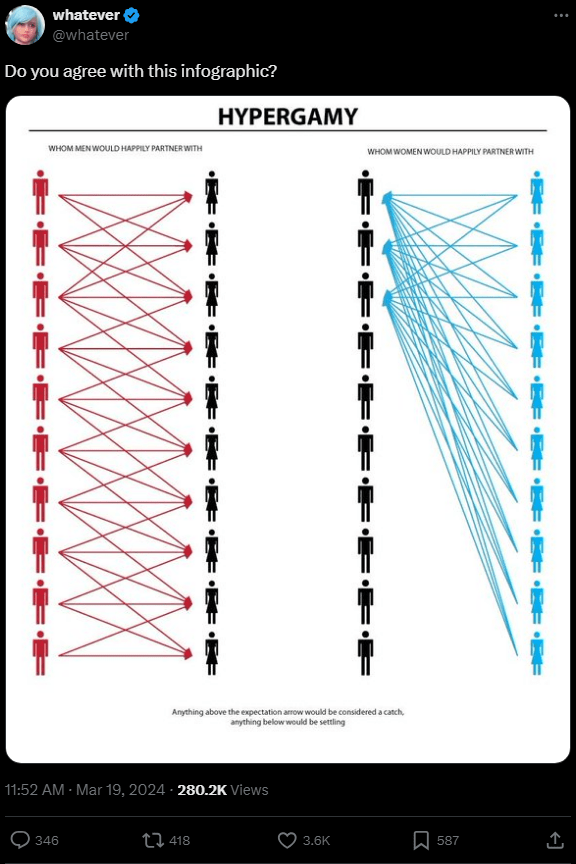
Some will protest, claiming that it’s a strawman and that their more ‘nuanced’ take on it is how it should really be interpreted, but most people who are familiar with this meme will probably agree that this is how it has been most commonly expressed.
The narrative that underpins the meme states that the sexual revolution opened the floodgates and has allowed for women to act out their promiscuous desires, but owing to their hypergamous nature, women’s promiscuity is focused on a narrow band of men, leaving the majority out in the cold. These are just the natural dynamics of the free and open sexual marketplace running their course you see, and this is why the strict enforcement of monogamy is so critical for social stability.
Scant evidence has been presented supporting this idea however. When pressed, its adherents will typically appeal to online dating statistics. The most commonly referenced are the OKCupid attractiveness ratings data and Tinder swipe data. The problem with this is that they have very little to say about actual sexual encounters. Also, when it comes to outcomes such as messages sent and replied to by the desirability of the senders and recipients, and dates, relationships, and one-night stands mediated by online dating, we actually see remarkable gender parity.
The real 80/20 rule
This idea is not completely without its merits however. Looking at the sex partner distribution of 18-24 heterosexuals, we see that there are certainly a minority of men who report a majority of the sex partners, and we’re not just talking 49/51.
What we also see however, is that a similar pattern emerges for women. A few percent more men reported very high lifetime opposite-sex sex partner counts for whatever reason (some degree of misreporting is generally the go to, escorts could also factor in), but the past year distributions show a high degree of balance. About 20% of men and women had 2 or more opposite-sex sex partners in the past year, though only a miniscule percentage of heterosexual young men and women could be described as engaging in any kind of wild promiscuity.
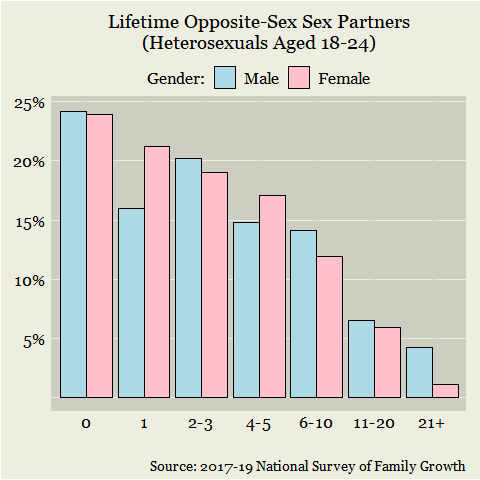
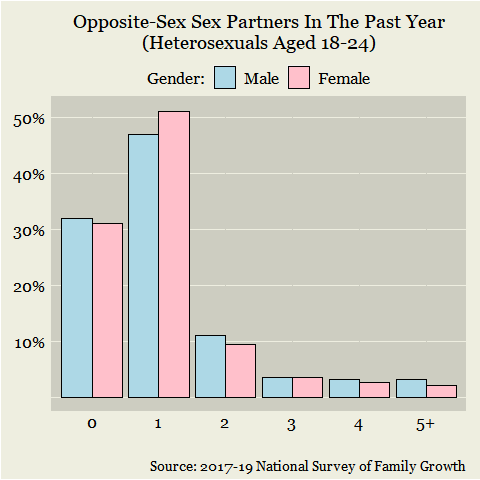
I didn’t think of it until now as I’m updating this but including bisexual women evens it out a bit more:
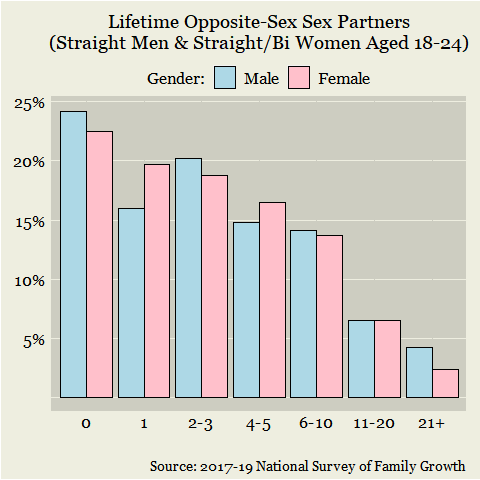
We see a similar pattern for casual sex partners among men and women aged around 26 in this large Swedish survey. In this case homosexual encounters may explain some of the gap in the higher partner counts. Only a bit above 20% of men and women had a casual sex partner within the past month, and very few of them had more than 1. So much for ‘hookup culture’.
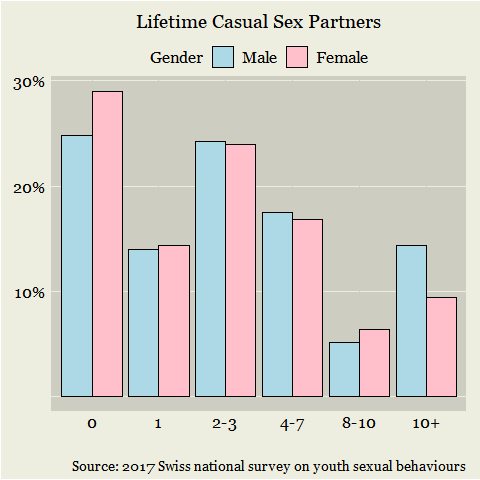
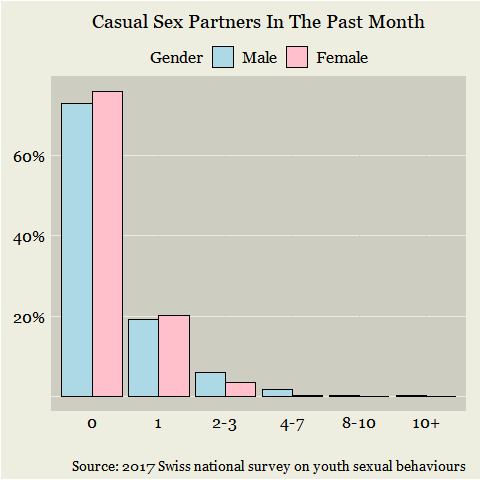
Below are the top 20%’s share of the lifetime sexual partners. The actual ratio seems to tend to fall a bit short of 80/20, but it should probably be seen as more of a rule of thumb. Also, lifetime sex partners is capped at 50 in the NSFG. Again, there is little gender difference to speak of.

The GSS has no such cap, but the sample size is much more limited so I’ve expanded the age range to 18-29. We see similar results for 30-45s for whose sexual careers have neared their end. The ratio has remained quite stable across the past 15 years.


Bearman et al. (2004) provided a more detailed examination of these sexual dynamics with a study of high school students who selected peers from a roster who they had had a sexual or romantic relationship with in the past 18 months. Below is the resulting human sextipede and all the patterns which emerged.
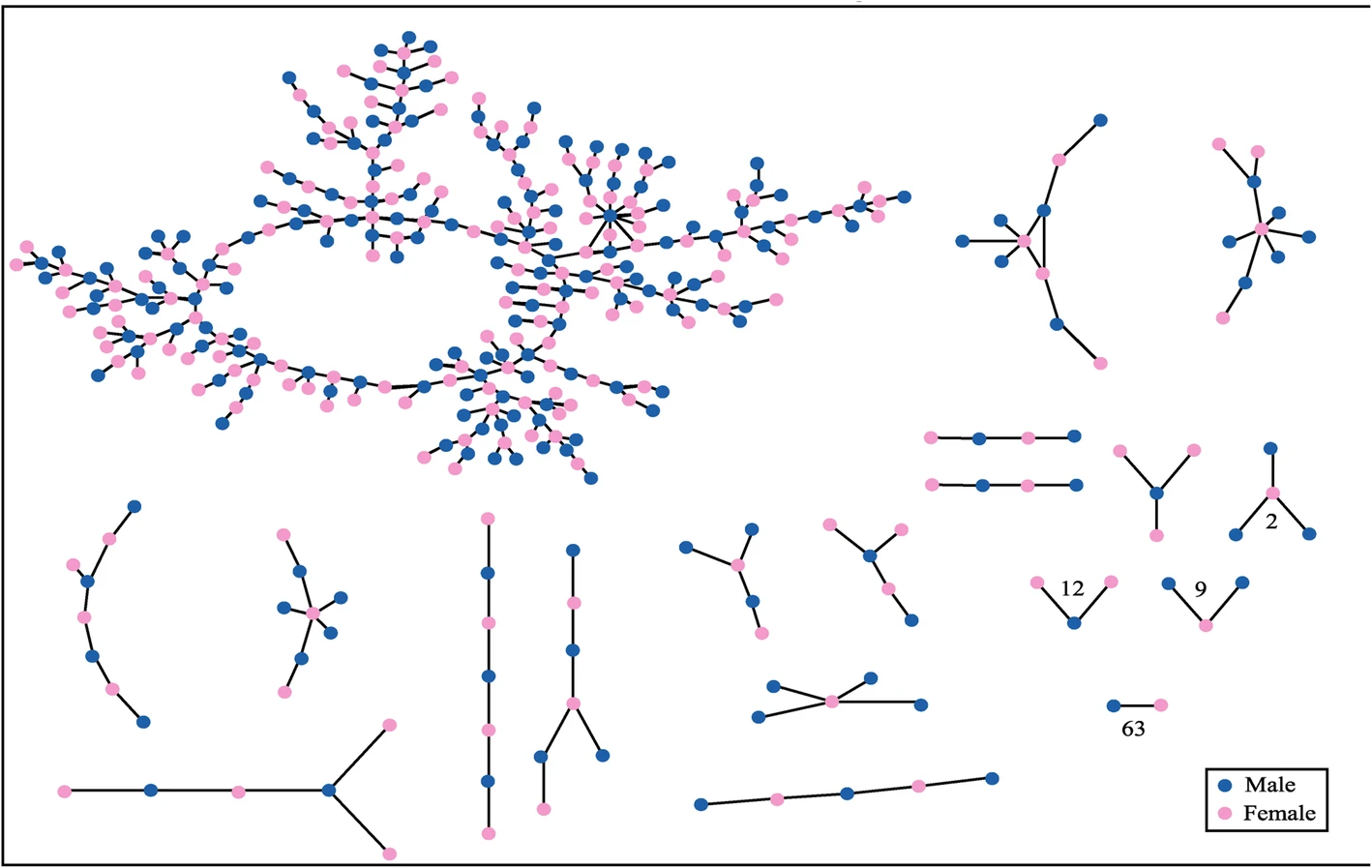
The 80/20 narrative would predict that the most promiscuous students would be disproportionately male, with many of the pink nodes monopolized by them. The closest thing we have to a ‘chad’ here is this little guy who managed to get with 9 girls:
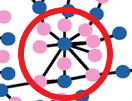
Notice however, that of the 9 only 2 of them were his partners exclusively, so this can hardly be considered a monopoly. Moreover, if we look overall at the nodes with the most connections, they are if anything disproportionately female. 19 women and 10 men had 4 partners. 4 women and 1 man had 5. 1 woman had six. It appears as if polyandrous Stacy harems are actually a more common setup here.
Just how chad is chad?
We’ve seen how facial attractiveness and height have relatively trivial associations with men’s number of sex partners, especially height, and this doesn’t appear to have changed in more recent years.
It also seems that objectively measured markers of developmental stability (which reflect an organism’s capacity to resist environmental and genetic stressors) including fluctuating asymmetry in the body and minor physical anomalies have very little to say about it (Kordsmeyer & Penke, 2017).
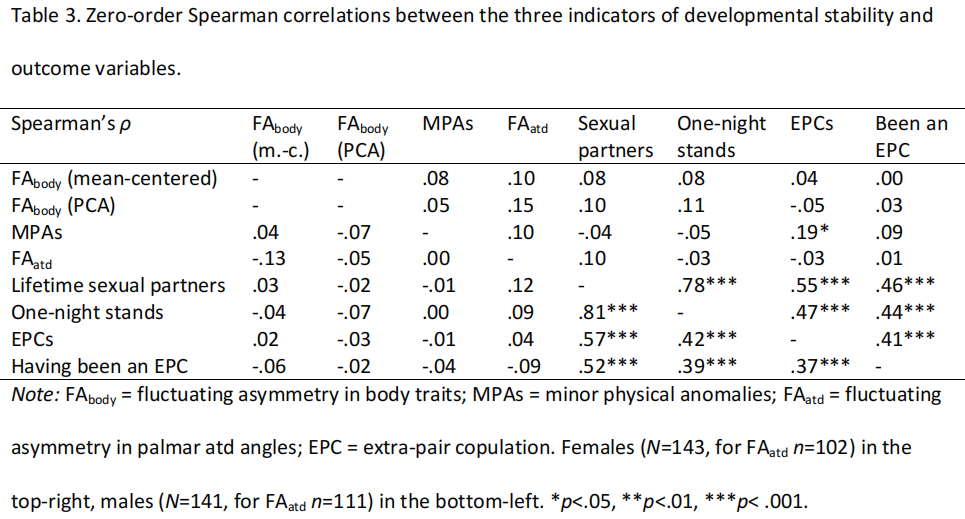
Sim & Chun (2016) looked at 2D:4D digit ratios (a proxy for prenatal testosterone exposure), shoulder-hip ratio (another sexually dimorphic trait with higher ratios typically being considered more attractive in men), and again fluctuating asymmetry.
Again we see null results all around. A highly significant correlation between assertiveness and number of sex partners was found however, and a smaller negative one for responsiveness (related to agreeableness). 13.8% of the variance in number of sex partners was explained by assertiveness, 3.5% by responsiveness, and just 1.7% by all three physical fitness indicators.
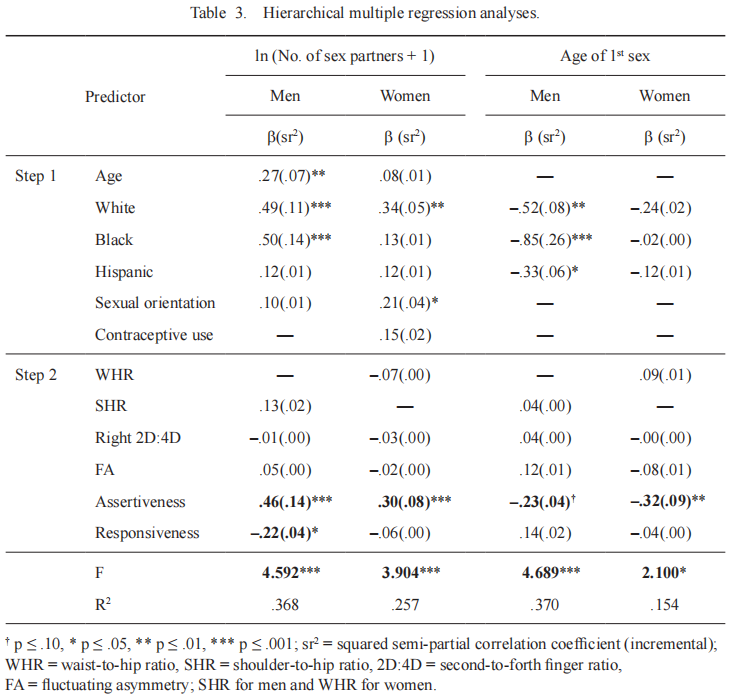
Foo et al. (2017) failed to find a connection between salivary immune function, oxidative stress, or semen quality and mating success (age at first sexual intercourse and number of sex partners). Similarly, Arnocky et al. (2023) failed to find a connection between salivary immunoglobulin A (a marker of immunocompetence) or poor health and number of sex partners.
You could probably tease out small effects with a big enough mass of data, but it’s also possible that the ‘good genes hypothesis’ may need some revising. This is the primary framework under which women’s short-term mating strategy (assuming they have one) has been understood, and it is tightly interlinked with the dual mating strategy theory, which entails acquiring resources from a committed long term partner while acquiring the ‘good genes’ (including physical attractiveness and masculine characteristics, which are thought to signal good health and a strong immune system) from an extra-pair copulation partner typically during the ovulatory phase when they’re most likely to conceive.
This hypothesis however has been struggling to find consistent empirical support.
David Buss has proposed an alternative which he dubbed the ‘mate switching hypothesis’:
There are several variants of the mate-switching hypothesis of women’s short-term mating. One involves cultivating a backup mate should something befall a woman’s regular mateship, such as a partner becoming injured, dying in a war, or in probabilistic anticipation of a potential breakup. This has been called the “mate insurance” function of short-term mating (Buss, 2016). Another variant involves having a short-term sexual encounter to make it easier to divest herself of an existing mate. A third variant involves trading up to a partner of higher mate value, or one who offers more benefits and fewer costs than her current partner. A fourth variant involves using short-term mating as a means of assaying her mate value to evaluate whether there might be more desirable and accessible potential partners on the mating market.
Buss (2023)
This as with the dual-mating hypothesis is focused on infidelity however. When it comes to short-term mating more generally, it may often be a stepping stone to long-term relationships. Owen & Fincham (2011) found that 65% of women and 45% of men with hook up experience reported hoping a committed relationship came out of it. It has been argued that short-term mating maybe somewhat counter-intuitively was selected to facilitate pair-bonds:
In contrast, AFT posits that short-term mating and other forms of mating outside of pair-bonds are natural by-products of a suite of attachment and caregiving mechanisms that, among other things, were selected for in human evolutionary history to ultimately enable men and women to seek, select, create, and maintain a pair-bond within which to rear offspring who would themselves survive to reproduce. There is a growing body of literature across numerous literatures both for humans and other pair-bonding species that is pointing to an increasingly coherent picture of the underlying biological and chemical systems involved in mating and parenting (e.g., Curtis and Wang 2003; Ziegler 2000). The attachment and caregiving systems provide parsimonious suites of underlying biological, chemical, and psychological mechanisms that generally operate similarly for men and women (Dixson 1998; Insel 1997; Goldstein 2000). These same suites of mechanisms are likely to have analogs in the development of child attachments to care-givers (Hazan and Zeifman 1999).
Pederson et al. (2011)
Otherwise, are personality traits like assertiveness the real good genes we should be looking at, or do they facilitate short-term mating through higher social engagement, more ballsy behaviour, and being more so inclined? Personally I’d say it’s probably more so the latter overall, but it’s an open question. You could also imagine some degree of reverse causation whereby a greater number of sexual encounters fostered more confidence, though I’d question personality’s ability to be molded substantially at a sexually mature age.
Whatever the case, the notion that only the finest specimens at the top of the hierarchy have the privilege of passing on their genes is a rather fanciful one given the way things are currently panning out. Instead, we are seeing the most impulsive, uninhibited, and simple-minded make the largest contributions to future generations (Hugh-Jones & Abdellaoui, 2022).
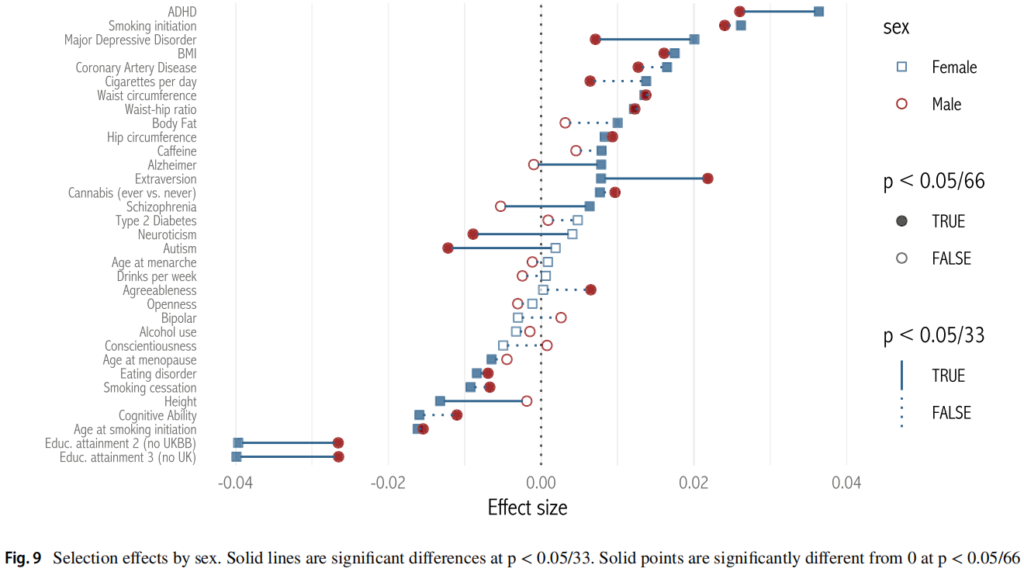
Finishing thoughts
The basic idea that some men sleep around a lot more than others is obviously valid. However, there is also equality when it comes to this inequality in the sense that women have a similarly skewed partner distribution. It is not the case as the manosphere implies that there is a promiscuous minority of men but majority of women. It’s also not the case that this leads to any sort of ‘monopoly’, especially since much of the sex had by the promiscuous minorities is probably had between each other.
This isn’t necessarily to say that men and women’s sexualities are equally self-restricted though. One need only look at the homosexual community to get a glimpse of unrestrained male sexuality. A large reason why most manospherians are offended by this kind of data is probably because they feel that women’s easy access to casual sex is an unjust privilege that they derive endless pleasure out of. It shouldn’t need to be said however that a big reason why this disparity in sexual access exists is simply because women aren’t as interested in casual sex as men on average, creating a basic supply and demand issue. Casual sex isn’t a resource which everyone wants more of or gets as much out of, even within the male gender. There’s no need to construct conspiracy theories around this disparity.
One of the more ‘nuanced’ takes on the 80/20 rule would be that it describes the proportion of men and women who ‘could get sex on demand if they wanted to’. I guess I’m more black pilled than them because I don’t think anywhere near 20% of men could find a female stranger to have sex with on demand, and 80% of women would probably be an understatement.
Another may be the idea that even if these lesser men aren’t celibate, they aren’t truly ‘desired’ in the same way as most women are. In terms of spontaneous sexual desire there’s probably some truth to this, but the vast majority of people report being very satisfied with their current relationships, not just the ones involving top 20% men. Although everyone has moments of insecurity, this is probably not something that causes unbearable mental anguish among emotionally stable neurotypical men.
Ultimately, these alternative takes feel like an attempt to salvage what is at some stage understood to be untenable, and seem only tenuously connected to the original purpose of the pareto principle.
Although it’s unlikely to be much more convincing to anyone who isn’t convinced by now, I will also be going into how STD statistics fail to show the predicted pattern in the next installment.
References
Bearman, Peter & Moody, James & Stovel, Katherine. (2004). Chains of Affection: The Structure of Adolescent Romantic and Sexual Networks1. American Journal of Sociology – AMER J SOCIOL. 110. 10.1086/386272.
Kordsmeyer, Tobias & Penke, Lars. (2017). The association of three indicators of developmental instability with mating success in humans. Evolution and Human Behavior. 38. 10.1016/j.evolhumbehav.2017.08.002.
SIM, Kyungok & CHUN, Woo. (2016). The relationships of assertiveness and responsiveness to sexual behavior. PSYCHOLOGIA. 59. 50-69. 10.2117/psysoc.2016.50.
Arnocky, S., Denomme, B., Hodges-Simeon, C., Hlay, J. K., Davis, A. C., & Brennan, H. (2023). Self-perceived Mate Value is Predicted by Biological and self-reported Indices of Health in Young Adults. Adaptive human behavior and physiology, 9(1), 54–71. https://doi.org/10.1007/s40750-022-00209-4
Buss, D. M. (2023). The sexual selection of human mating strategies: Mate preferences and competition tactics. In J. K. Mogilski & T. K. Shackelford (Eds.), The Oxford handbook of evolutionary psychology and romantic relationships (pp. 15–41). Oxford University Press. https://doi.org/10.1093/oxfordhb/9780197524718.013.1
Owen, J., & Fincham, F. D. (2011). Effects of gender and psychosocial factors on “friends with benefits” relationships among young adults. Archives of Sexual Behavior, 40(2), 311–320. https://doi.org/10.1007/s10508-010-9611-6
Pedersen, W. C., Putcha-Bhagavatula, A., & Miller, L. C. (2011). Are men and women really that different? Examining some of Sexual Strategies Theory (SST)’s key assumptions about sex-distinct mating mechanisms. Sex Roles: A Journal of Research, 64(9-10), 629–643. https://doi.org/10.1007/s11199-010-9811-5
Hugh-Jones, D., & Abdellaoui, A. (2022). Human Capital Mediates Natural Selection in Contemporary Humans. Behavior genetics, 52(4-5), 205–234. https://doi.org/10.1007/s10519-022-10107-w

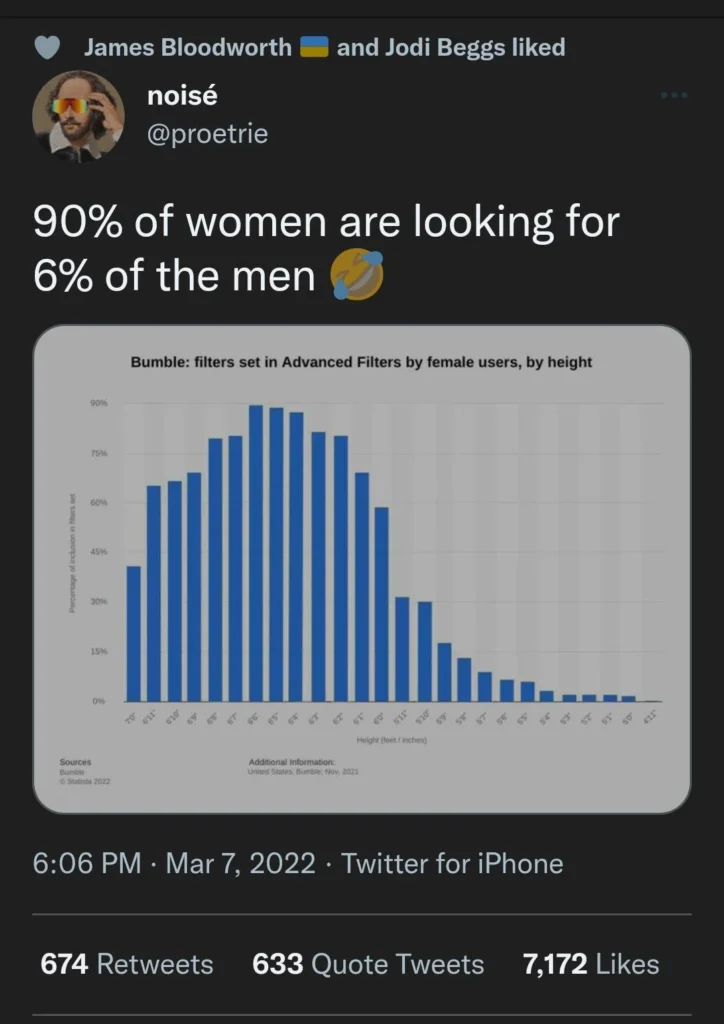

Never trust data from an organization with the word”Family” in its name,
I have read some excellent stuff here Definitely value bookmarking for revisiting I wonder how much effort you put to make the sort of excellent informative website
Точно важные новости мировых подиумов.
Все эвенты самых влиятельных подуимов.
Модные дома, бренды, высокая мода.
Новое место для модных хайпбистов.
https://worldsfashion.ru/
Самые трендовые новости мировых подиумов.
Важные мероприятия лучших подуимов.
Модные дома, лейблы, высокая мода.
Свежее место для модных хайпбистов.
https://fashionsecret.ru
Hey there, I love all the points you made on that topic. There is definitely a great deal to know about this subject, and with that said, feel free to visit my blog Webemail24 to learn more about Data Mining.
I have read some excellent stuff here Definitely value bookmarking for revisiting I wonder how much effort you put to make the sort of excellent informative website
I loved as much as youll receive carried out right here The sketch is tasteful your authored material stylish nonetheless you command get bought an nervousness over that you wish be delivering the following unwell unquestionably come more formerly again since exactly the same nearly a lot often inside case you shield this hike